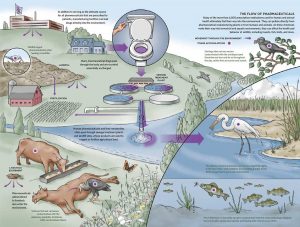One of the most pressing dangers in our drinking water is pharmaceutical drug residues due to its small molecular size (which enables it to penetrate our bodies), potency (a small dose has a big impact) and ability to bypass modern wastewater and water treatment plants as well as most water filtration systems.
More than 100 different pharmaceuticals have been detected in lakes, rivers, reservoirs and streams throughout the world in Asia, Australia, Canada and Europe – even in Swiss lakes and the North Sea.
How do drugs get into our drinking water?
- Drug consumption
Many drugs end up in toilets, unmetabolised by our body or flushed down the toilet, thus entering sewage treatment plants. Drugs that are not properly disposed of can also contaminate underground water sources via landfills. - Healthcare industry
Hospitals and long-term care facilities in the U.S. throw away an estimated 113.4 million kilogrammes of unused drugs and contaminated packaging annually. - Agriculture and aquaculture
Antibiotics and other drugs are given to animals as part of veterinary treatments, and residues and farm runoffs frequently enter streams and river systems. Drug residues have also been found in water used for aquaculture. - Pharmaceutical facilities
In a study by U.S. Geological Survey (USGS) from 2004-2009, it was discovered that wastewater treated near pharmaceutical manufacturing facilities contained 10-1,000 higher concentrations of drugs.

Drugs, including cholesterol medications, tranquilisers and anti-epileptic medications, resist modern drinking water and wastewater treatment processes. Up to 90% of pharmaceuticals pass through the human body into sewage treatment plants which are not designed to remove them. On top of that, drinking water treatment plants often add chlorine to disinfect water, which may even increase the toxicity of some drugs!
According to a report by the Associated Press, one technology that can remove virtually all pharmaceutical contaminants in drinking water is reverse osmosis. Even though all drinking water treatment plants can adopt this technology, it is expensive to replace their existing systems as well as highly impractical as about 99% of treated water delivered to households are used for bathing, flushing toilets, cleaning purposes, gardening and so on.
This puts the onus on the individual consumers to purify their own drinking water via home treatment systems. Good systems are not necessarily the most popular or well known. What is most important is the technology that they utilise as well as certification by independent bodies such as the WQA Gold Seal.

